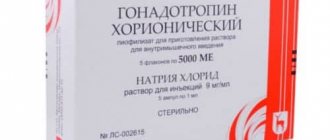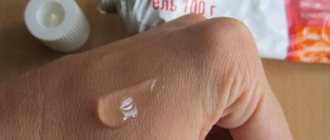Causes and symptoms of bronchial asthma
Asthma develops due to the harmful effects of pathological factors on the cells of the respiratory system. As a result of this, the bronchi begin to produce a large amount of secretion, and the bronchial lumens narrow - it is impossible to remove mucus through them. Air cannot pass freely through the respiratory tract, resulting in coughing, suffocation, and a feeling of heaviness and congestion in the chest. An attack can provoke rapid death of the patient due to acute cerebral hypoxia or stroke. Therefore, it is so important to carry out primary and secondary prevention of bronchial asthma.
The cause of the disease is considered to be the impact of harmful factors on the respiratory, nominal and endocrine systems of humans. Factors can be divided into 2 groups – internal and external.
Internal factors include a hereditary predisposition to asthma. Doctors believe that heredity causes the disease in 35% of cases. The second factor is considered to be malfunctions of certain body systems - immune and endocrine.
There are much more external causes of bronchial asthma. These include:
- Deterioration of the environmental situation.
- Allergies to dust, pollen, medications, household chemicals, etc.
- Professional factor (if a person works in a hazardous industry).
- Hypovitaminosis.
- Addiction to unhealthy foods containing large amounts of sugar, fast carbohydrates, food dyes and preservatives.
- Smoking.
- Stressful situations.
- Chronic diseases of the respiratory system leading to bronchial obstruction.
- Pathogenic microorganisms – viruses, bacteria and fungi.
Under the influence of at least one of these factors, the human body starts the process of blocking the lumens of the bronchi, which results in an attack of suffocation.
Patients suffering from bronchial asthma note the characteristic symptoms of this disease:
- wheezing;
- dyspnea;
- severe cough at night;
- rapid and shallow breathing;
- pale skin;
- tachycardia;
- dizziness and headache.
During an attack, it is important to provide timely assistance to the patient, otherwise a rapid deterioration of the condition may begin, which can lead to death. However, it is better to carry out preventive measures in time so as not to encounter this terrible disease in the future.
The importance of disease prevention
Almost anyone can get asthma.
If a person is familiar with these factors first-hand, then he automatically falls into the risk group:
- Frequent manifestations of colds.
- Working to the detriment of one’s own health (a person goes to his workplace and ignores ARVI, runny nose, etc.).
- Physical activity that is very exhausting (spends a lot of time at work or in the gym all weekdays and devotes himself there to his last strength, and all weekends are spent resting).
- Ignoring the manifestations of fatigue, a depressed state (the first signs of depression due to recently experienced stress.) Thus, the body makes it clear to its owner that it needs rest.
First of all, prevention of bronchial asthma is a careful and respectful attitude towards yourself and your body.
Disease prevention is important. Especially for those people who are exposed to exhausting work or frequent stressful situations.
If prevention is not started, the disease will certainly arise and progress. The list of allergens to which a person reacts will increase significantly.
For example, if a patient reacted only to ragweed pollen, then in the future pollen of any flowers will not give him peace.
This affects the “expansion of the painful season”: if previously discomfort only occurred in August, then after a couple of years they will appear in May, June, etc.
In addition to antispasmodic effects, deformations appear on the walls of the bronchi, and even if contact with the allergen has stopped, they remain narrowed.
People who do not prevent the disease usually do not have the opportunity or time to treat it. As a result, the disease starts and increasingly poisons the patient’s life.
Primary prevention of bronchial asthma
Using an inhaler
Preventive measures and treatment of bronchial asthma are aimed at preventing attacks of suffocation or relieving it. In medicine, two terms have emerged - “primary” and “secondary prevention of bronchial asthma.” It is necessary to find out what the differences between them are.
Primary prevention of bronchial asthma includes measures to eliminate the causes that can provoke the disease. Compliance with these measures is also aimed at preventing the disease from developing. These instructions must be followed, first of all, by those patients who are at constant risk: people with allergic reactions, residents of megacities due to unfavorable environmental conditions, chemical production workers, including pharmacists, smokers, children, as well as those patients who have a tendency to frequent relapses of bronchitis.
All of these categories of potential asthmatics must comply with the following rules:
- Carry out daily wet cleaning of the house: wipe cabinets, shelves, appliances, be sure to wash the floors.
- Do not put anything under the bed, because... this will interfere with high-quality wet cleaning.
- Avoid carpets, large soft toys, open shelves with books, and artificial flowers. All these items are capable of accumulating dust - and this is one of the most powerful allergens.
- Use exclusively hypoallergenic bedding and accessories.
- Change bed linen at least once every 2 weeks. It must be washed at a temperature of at least 60 degrees.
- In hot weather, bedding should be taken out for airing.
- It is necessary to reduce the number of indoor flowers to a minimum.
- Try not to have pets. Their fur can cause allergies.
- Quitting smoking, including passive smoking, and drinking strong alcoholic beverages.
- Avoid household aerosols with strong fragrances. This requirement also applies to perfumes.
- For daily hygiene, it is better to use baby soap rather than shower gels and liquid soap.
- Strict adherence to a diet that excludes allergens: nuts, chocolate, products containing preservatives and dyes, etc.
- Hardening.
- Regular walks in the fresh air away from roads and factories.
- If a person working in hazardous work has a tendency to get sick, change his or her occupation.
- Annual holidays in sanatoriums on the seashore and in the mountains.
- Timely prevention and treatment of respiratory diseases.
- Refusal from various dietary supplements.
It is necessary to talk separately about the prevention of asthma in children, because this group of potential patients is always at risk due to an imperfect immune system. This is especially true for children whose immediate relatives have suffered from this disease or are prone to allergies.
The main preventive measure for babies under one year of age is full breastfeeding, because... Human milk contains everything necessary for the development of immunity and the development of normal intestinal flora. Formula-fed children are more susceptible to developing food allergies.
It is not recommended to introduce the first complementary foods before 6 months. It should not be varied and contain foods with a high allergenic index: citrus fruits, strawberries, honey, eggs, cocoa. During complementary feeding, it is better to avoid canned purees and juices, because... they all contain preservatives.
By following these simple principles of primary prevention of bronchial asthma, you can significantly reduce the risk of developing this dangerous disease in adults and children.
1. Drug treatment of asthma. Asthma medications
Basic therapy for bronchial asthma affects the mechanism of the disease and allows it to be controlled. Basic therapy drugs include: glucocorticosteroids (including inhaled ones), cromones, leukotriene receptor antagonists and monoclonal antibodies.
Symptomatic therapy allows you to influence the smooth muscles of the bronchial tree, as well as relieve asthma attacks. Symptomatic therapy drugs include bronchodilators: β2-adrenergic agonists and xanthines.
Let's look at medications for bronchial asthma in more detail...
Basic therapy for bronchial asthma
Glucocorticosteroids. They are used in the treatment of mild and moderate asthma, as well as to prevent exacerbations of its course. This series of hormones helps to reduce the migration of eosinophilic and leukocyte cells into the bronchial system when an allergen enters it, which in turn leads to a reduction in pathological processes in the lumen of the bronchi and edema. In addition, glucocorticosteroids slow the progression of the disease. To minimize side effects, glucocorticosteroids are used as inhalation. During exacerbations of the disease, their use is not effective.
Read also Varicose veins - causes, symptoms and treatment of varicose veins on the legs
Glucocorticosteroids for AS, Singular.
Leukotriene receptor antagonists (leukotrienes). They are used for all degrees of asthma severity, as well as in the treatment of chronic obstructive bronchitis. Effectiveness has been observed in the treatment of aspirin-induced bronchial asthma. The principle of action is to block the connection between cells that migrate into the bronchial tree when an allergen enters it and the mediators of these cells, which actually lead to a narrowing of the bronchial lumen. Thus, swelling and secretion production by the walls of the bronchial tree are stopped. The disadvantage of drugs from a number of leukotriene receptor antagonists is their lack of effectiveness in the treatment of isolated asthma, which is why they are often used in combination with hormonal drugs (glucocorticosteroids), which, by the way, increase the effectiveness of these drugs. Another disadvantage is the high price of these products.
Leukotriene receptor antagonists for asthma: zafirlukast (“Acolat”), montelukast (“Singulair”), pranlukast.
Cromons. They are used for stage 1 (intermittent) and stage 2 (mild) bronchial asthma. Gradually, this group of drugs is being replaced by inhaled glucocorticosteroids (ICS), because the latter, with a minimum dosage, have better efficiency and ease of use.
Cromones for asthma: sodium cromoglycate (Intal), nedocromil sodium (Tyled).
Monoclonal antibodies. It is used in the treatment of stages 3 (moderate) and 4 (severe) bronchial asthma, and allergic asthma. The principle of action is the specific effect and blocking of certain cells and their mediators in the disease. The disadvantage is the age limit - from 12 years. It is not used during exacerbations of the disease.
Monoclonal antibodies for AS, Omalizumab.
Allergen-specific immunotherapy (ASIT). It is a traditional method of treating exogenous bronchial asthma in patients aged 5 to 50 years. ASIT is based on the transfer of the body's immune response to an allergen from the Th2 type to the Th1 type. At the same time, the allergic reaction is inhibited, and the hypersensitivity of the tissues of the bronchial lumen to the allergen is reduced. The essence of treatment using the ASIT method is the gradual introduction, at certain intervals, of a small dose of allergens. The dose is gradually increased, thereby developing the resistance of the immune system to possible allergic agents, for example, dust mites, often contained in house dust. Among the introduced allergens, the most popular are mites, tree pollen and fungi.
Symptomatic treatment of bronchial asthma
Short-acting β2-adrenergic agonists (beta-agonists). They are the most effective group of drugs (bronchodilators) for relieving exacerbations and attacks of bronchial asthma, without limiting the age group of patients. The fastest effect (from 30 to 120 minutes) and with fewer side effects is observed in the inhaled form of beta-agonists. Well protects against bronchospasms during physical activity.
Short-acting β2-adrenergic agonists for asthma: salbutamol (Ventolin, Salamol Steri-Neb), terbutaline (Bricanil), fenoterol (Berotec).
Long-acting β2-adrenergic agonists (beta-agonists). They are used to relieve asthma attacks and exacerbations, as well as their frequency. When drugs based on the substance salmeterol are used to treat asthma with respiratory complications, cases of death have been observed. Formoterol-based drugs are safer.
Long-acting β2-adrenergic agonists for AS), formoterol (“Oxis”, “Foradil”), indacaterol.
Xanthines. They are used for emergency relief of asthma attacks, but mainly in cases where other drugs are not available, or to enhance the effectiveness of beta-agonists. However, β2-agonists are gradually replacing the xanthines that were previously used before them. The effectiveness of the simultaneous use of xanthines, for example drugs based on theophylline, together with ICS or SGCS has been noted. Xanthines are also used to eliminate daytime and nighttime asthma attacks, improve lung function, and reduce the dosage of hormones in severe asthma in children.
Xanthines with as, "Theotard", "Theophylline", "Euphylline".
Inhalers for bronchial asthma
Asthma inhalers are small (pocket) inhalers that can quickly deliver the active drug for asthma to the desired location in the respiratory system. Thus, the drug begins to act on the body as quickly as possible, which in some cases allows minimizing acute attacks with all the consequences of the attack. Inhalers for asthma include the following:
Inhaled glucocorticosteroids (ICS): non-halogenated (budesonide (Benacort, Budenit Steri-Neb), ciclesonide (Alvesco), chlorinated (beclomethasone dipropionate (Bekotide, Beclazon Eco), mometasone furoate (Asmanex) "")), fluorinated (azmocort, triamcenolone acetonide, flunisolide, fluticasone propionate).
b2-adrenomimetics: short-acting (“Ventolin”, “Salbutamol”), long-acting (“Berotek”, “Serevent”).
Anticholinergics: Atrovent, Spiriva.
Cromons: “Intal”, “Tailed”.
Combined drugs: “Berodual”, “Seretide”, “Symbicort”. They have a very fast effect that relieves attacks of bronchial asthma.
Other medications for the treatment of bronchial asthma
Expectorants. Helps reduce the viscosity of sputum, loosen mucus plugs, and remove sputum from the respiratory tract. Efficiency is noted through the use of expectorants through inhalation.
Expectorants: Ambroxol, Codelac Broncho.
Antibacterial agents (antibiotics). They are used when asthma is combined with infectious diseases of the respiratory system (sinusitis, tracheitis, bronchitis, pneumonia). Antibiotics are contraindicated for children under 5 years of age. Antibiotics are selected based on diagnosis, depending on the type of pathogen.
Antibiotics include: Tetracycline, Erythromycin (for mycoplasma infection), penicillin and cephalosporin (for streptococcal infection).
Secondary prevention of bronchial asthma
Protecting the body in spring
If the patient was unable to prevent all negative factors and the disease developed, secondary prevention of bronchial asthma is necessary. It includes measures to prevent complications in people with asthma. To reduce the number of attacks and their intensity, pulmonologists recommend following recommendations that complement primary prevention measures:
- Try to be outside less in the spring, when many plants, whose pollen is a powerful allergen, bloom.
- Beware of insect bites.
- Use massage and self-massage of the chest and back massage.
- Always have an inhaler with you.
- It is possible, on the recommendation of a doctor, to use alternative medicine methods - acupuncture, reflexology.
- Performing breathing exercises.
- Regular visits to salt rooms or caves have a good therapeutic effect.
- Monitor the course of acute respiratory diseases and bronchitis. To prevent them, you need to constantly humidify the air in the room, sleep with the windows open, and use vitamin and mineral complexes.
- During the flowering period of plants that cause allergies, it is good to go to another climatic zone, preferably to the sea. However, such travel can only be done after an exacerbation of the disease, and not during the period. Otherwise, such a trip may worsen the course of asthma.
- Do not wear clothes made of fur or wool.
- It is necessary to have dinner 2 hours before bedtime, because an overfilled stomach can trigger an asthma attack at night.
If you follow secondary prevention measures for bronchial asthma, you can achieve stable remission of the disease.
Prevention of bronchial asthma, consisting of two stages, allows you to minimize the risk of the disease in people prone to its occurrence, as well as make life and the course of the disease easier for those patients who are faced with this disease.
Basic measures to prevent the disease
As you know, it is easier to prevent the development of a disease than to allow its occurrence and treat associated symptoms and complications. A set of medical measures used to prevent illness is called prevention. This is a fairly broad concept, divided into 3 types.
Primary prevention is the most effective measure aimed at eliminating those factors that lead to the disease. This is, first of all, a healthy lifestyle, physical exercise, quality nutrition, giving up bad habits, etc. It is aimed at preventing the onset of the disease in principle.
Secondary prevention contains a set of measures that are aimed at identifying the disease in its asymptomatic period or at an early stage of development, as well as preventing the development of pronounced symptoms.
Tertiary prevention is measures used to stop complications and relapses of an existing disease.
Tertiary prevention
In the case of bronchial asthma, this type of prevention is aimed at improving the patient’s condition during an attack and preventing the development of complications of the disease. Almost all of these measures involve taking medications.
They come in three groups:
- bronchodilators;
- hormonal medications for inhalation;
- hormonal drugs for oral administration.
All of them relieve the unpleasant symptoms that arise, but only the attending physician can determine the advisability of prescribing a particular drug and its dosage.








